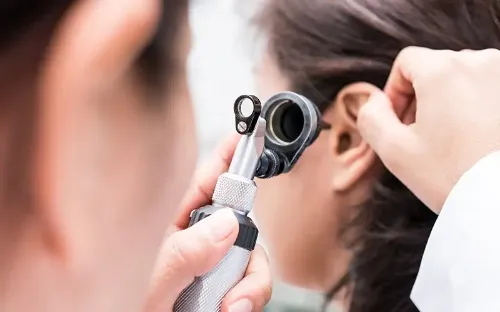Acute otitis media
"A complete head and neck scan is necessary to identify factors that predispose to this type of problem".
DR. FRANCISCO JAVIER CERVERA
SPECIALIST. OTORHINOLARYNGOLOGY DEPARTMENT

What is otitis media?
Otitis media is an inflammation or infection of the middle ear, that is, the part of the ear that is located just behind the eardrum. It usually appears when fluid builds up in that area (often after a cold, flu, or respiratory infection) and that fluid becomes infected by viruses or bacteria.
Approximately 70% of children have had an episode of otitis media. It affects all age groups but is most common between 0 and 7 years old.
There are two clinical forms of acute otitis media (AOM): sporadic and recurrent. This in turn is divided into:
- Persistent is when a new episode of AOM occurs within a week of the completion of a previous episode, so both episodes are considered to be the same.
- Recurrent if the new acute process occurs after one week, so they are assumed to be separate episodes.
- Tilt or propensity: if there are 3 or more episodes of recurrence in 6 months or 5 in 12 months.

What are the symptoms of otitis media?
Acute otitis media (AOM) is usually preceded by an upper respiratory tract infection by several days. Suddenly, otalgia appears with fever, malaise and hearing loss.
In infants, symptoms may be limited to irritability, diarrhea, vomiting, or general malaise.
Most common symptoms:
- Earache.
- Fever.
- Discomfort.
- Loss of hearing.
Do you have any of these symptoms?
You may have acute otitis media
What are the causes of otitis media?
The most common cause is Streptococcus pneumoniae.
Other germs involved are: Haemophilus influenza, Moraxella catarrhalis.
How is otitis media diagnosed?

Specific signs and symptoms such as otalgia, acute otorrhea, or otoscopy with unequivocal evidence of inflammation should be considered in the diagnosis of acute otitis media. The hyperemic, opaque, and bulging eardrum may be observed with poor motility.
In the infantile one is very characteristic the abrupt awakening and the disconsolate crying several hours after a deep dream or the diurnal irritability unjustified and prolonged.
The use of home swabs or instruments such as blunt needles often push the wax further into the ear canal and increase the possibility of trauma.
How is otitis media treated?
It may be helpful to gently irrigate the ear canal with a syringe and to use cerumen softening products.
Oral antibiotics are used as medical treatment, with amoxicillin being the first choice.
In children who have recently been treated with amoxicillin or who live in areas with a high incidence of resistance produced by beta-lactamases, amoxicillin clavulanic or a second generation cephalosporin would be the choice.
Where do we treat it?
IN NAVARRA AND MADRID
The Department of Otolaryngology
of the Clínica Universidad de Navarra
The Department of Otorhinolaryngology of the University of Navarra Clinic is a national and world reference in numerous highly specialized surgical procedures.
We have the latest technology and we perform all diagnostic tests in less than 48 hours in order to offer our patients the best solution in the shortest time possible.
We were one of the first centers in Spain to use robotic surgery in the surgical treatment with the Da Vinci® System.
Organized in specialized units:
- Otology - Hearing.
- Rhinology - Nose.
- Pharyngology - Throat.
- Laryngology - Voice.
- Balance disorders.
- Head and neck problems.

Why at the Clinica?
- Experts in the treatment of hearing problems.
- Pioneers in axillary surgery to avoid scarring.
- National reference center in tissue sealing for tonsil removal.













